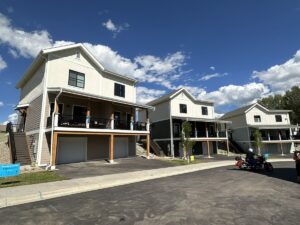Permanent Modular Construction for Educational Buildings
Permanent modular construction (PMC) is changing how schools are built by offering efficiency and flexibility. This method constructs building sections off-site in a factory-controlled environment and then assembles them on-site. As a result, educational facilities are designed, built, and occupied more quickly and cost-effectively, meeting the needs of modern learning environments.
What is Modular Construction?
Modular construction builds structures in sections or modules in a controlled factory setting. These modules are then transported to the construction site and assembled into a complete building. This method significantly reduces on-site construction time and minimizes disruptions, making it ideal for educational buildings where timely completion is crucial. Permanent Modular Construction meets or exceeds all required building codes and is constructed on a permanent foundation. It matches site-constructed buildings in appearance and uncompromised building performance. In fact, the controlled manufacturing process typically allows modular buildings to outperform their site-constructed counterparts.
Application in Educational Buildings
Modular construction suits educational facilities well because it accommodates a variety of spaces and functions. From classrooms to gymnasiums, modular construction provides a scalable and adaptable solution.
- Classrooms: Modular classrooms offer flexibility and adaptability. They meet specific educational requirements, including size, layout, and technology integration. The off-site construction process ensures high-quality finishes and compliance with educational standards. Classroom widths typically require two modules that are open to each other.
- Bathrooms: Prefabricated bathroom modules ensure consistent quality and design. They can be delivered and installed quickly, reducing disruption to the school environment. A single module can accommodate an entire bathroom with all required plumbing fixtures.
- Administrative Offices: Modular construction allows rapid deployment of administrative spaces tailored to the school’s needs. Schools can expand or reconfigure these offices as they grow. Modules can easily accommodate smaller office sizes.
- Larger Spaces: Spaces such as cafeterias, gymnasiums, and auditoriums present unique challenges. However, modular construction has evolved to meet these demands as well. Schools can efficiently assemble these larger spaces on-site by using larger prefabricated sections, bounding the space with other modules, or the use of pre-fabricated panels to accommodate the larger expanses. Additionally, modular construction allows for the integration of specialized systems, such as acoustics in auditoriums or advanced ventilation in gymnasiums.

Efficiencies and Impact on Construction Schedule
Modular construction saves time by allowing simultaneous off-site module construction and on-site preparation. Contractors can complete schools 30-50% faster compared to traditional construction. This enables completion of larger construction projects during the short summer break timeframe.
Modular construction is also cost-efficient. Factory-controlled construction minimizes material waste and reduces labor costs, lowering overall project costs. The standardized production process drives down expenses.
Quality control is another advantage of modular construction. Modules are built in a controlled environment, ensuring consistent quality and adherence to building codes. This precision leads to fewer on-site issues and a smoother construction process.
Modular construction reduces disruptions to existing school operations by minimizing on-site work. This benefit is especially valuable for schools that need to expand or renovate while classes are in session.
Impact on Project Costs
The efficiencies of modular construction result in significant cost savings for educational buildings. Factory-based construction requires less on-site labor, reducing labor costs by 10-20%. The controlled environment also ensures precise material usage, cutting material costs by up to 15%.
The faster construction time allows schools to open sooner, leading to a quicker return on investment. Additionally, modular construction enables schools to expand by adding new classrooms or facilities as needed without significant disruption or cost.
Conclusion
In summary, permanent modular construction offers a practical solution for building educational facilities. By using modular methods, schools benefit from faster construction timelines, cost efficiencies, and high-quality spaces tailored to modern educational needs. From classrooms to gymnasiums, modular construction provides a flexible, scalable approach that ensures educational environments can adapt to future demands.
References
- Modular Building Institute (MBI). (2023). Permanent Modular Construction for Education. Retrieved from MBI
- National Institute of Building Sciences (NIBS). (2022). Modular Construction in Education: A Guide to Best Practices. Retrieved from NIBS
- American Institute of Architects (AIA). (2023). Designing Schools with Modular Construction: Efficiency and Innovation. Retrieved from AIA









